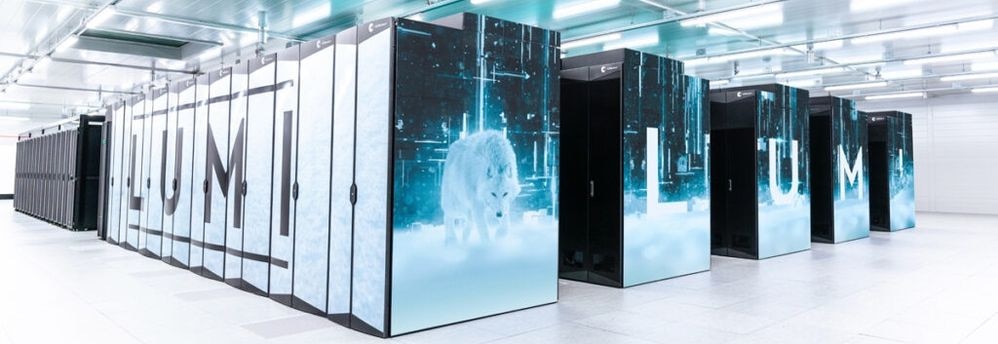Three Ways the LUMI Supercomputer is Changing the World
Apr 25, 2025

If you’re a fan of science fiction movies, you’ve probably seen the story where countries come together to avert or overcome a crisis. These films usually begin with some unexpected dangerous event — maybe an alien invasion, a pandemic or rogue robots. Earth’s smartest scientists and engineers work non-stop to discover a solution. Governments pool their resources and, in the end — usually at the very last possible second — humanity triumphs.
This might seem like a Hollywood fantasy, but believe it or not, this movie plot is playing out in real life right now. No, we aren’t facing an alien invasion or fighting off AI overlords, but the earth does face some pretty serious crises. And nations of the world are working together to develop technology to help address those problems.
For example, the LUMI supercomputer, located in Kajaani, Finland receives a portion of its funding from the European High-Performance Computing Joint Undertaking (EuroHPC JU), an effort that pools EU resources to create/provide exascale computing platforms. Additional funding comes from LUMI consortium countries,which includeFinland, Belgium, Czech Republic, Denmark, Estonia, Iceland, the Netherlands, Norway, Poland, Sweden and Switzerland.
According to the Top500 list published in November 2024, LUMI is the 8th fastest supercomputer in the world and the fastest supercomputer in Europe. The final configuration of the LUMI supercomputer can sustain 380 petaflops of performance, which is roughly the equivalent of 1.5 million high-end laptops. It’s based on the HPE Cray EX platform with AMD EPYC™ CPUs and AMD Instinct™ MI250X GPUs.According to the Green500 list, LUMI is also the world’s 25th most energy efficient supercomputer. It runs on 100% hydropower and the waste heat from the facility is recaptured to heat about 100 homes in Kajaani.
While LUMI’s immense computing power enables a long list of projects, here are three ways teams are using this supercomputer to change the world.
1. Addressing climate change
Figuring out how to reduce the earth’s warming trend and deal with its impact is one of the biggest crises humans face.Among the climate-related projects that make use of LUMI, one of the most exciting is Destination Earth. This digital twin project accurately models the planet down to a resolution of five kilometers. This project generates about a petabyte of data per day, impossible to process without a supercomputer.
In the past, climate scientists were able to update their predictions about the impact of climate change about once every seven to ten years. With Destination Earth, they can now publish new forecasts once or more every year, greatly increasing predictive accuracy, allowing for humanity to prepare.
In addition, the model allows scientists to see what might happen under a variety of different conditions. For example, if government agencies are considering new weather-related policies, Destination Earth allows them to model the impact of the policies to see how effective they will be at reducing or mitigating the effects of global warming.
2. Forecasting natural disasters
The work with Destination Earth also makes it possible for LUMI to forecast natural disasters including hurricanes, cyclones, floods, and droughts. In fact, climate change contributed to the deaths of at least3,700 people in 2024. Scientists hope that better analytical capabilities could help them reduce that number even as the number of disasters increases.
In addition to the Destination Earth project, the LUMI supercomputer also contributes to work done by the European High-Performance Computing Centre of Excellence for Exascale on Solid Earth (ChEESE CoE). One project is working to accurately anticipate glacier outburst floods. Glacier outburst flooding poses a significant risk in Iceland, which is one of the LUMI supercomputer consortium countries. These events are notoriously difficult to predict because of several factors — temperature, weather, ice melt and small seismic events — interact in complex ways, in areas that are physically difficult to access. These floods pose a significant risk in Iceland, one of the LUMI consortium countries. Scientists from several different organizations are using Elmer/Ice software on the LUMI system to simulate these sudden glacier outburst floods that endanger communities in Iceland, in hope of providing earlier warnings to help save lives.
LUMI and the ChEESE CoE are also involved in other projects analyzing volcanic ash, fires, earthquakes, hydrology and more. The LUMI system has dedicated cycles set aside for urgent computing, and LUMI is involved with projects bringing AI to weather forecasting.
3. Treating disease
LUMI is a key resource for life sciences research, providing insight into disease identification and treatment. One of its first projects was ComPatAI, a project that uses deep learning techniques to analyze tissue samples. “Our work has focused mainly on prostate and breast cancer,” explains Pekka Ruusuvuori, Associate Professor of the Institute of Biomedicine at the University of Turku. “There is ample data available on these types of cancers, as they are the most commonly encountered cancers in men and women. However, we want to create a very general-purpose model that could then be further refined for different and new applications.”
The project receives digital slides from Fimlab, the largest healthcare lab services provider in Finland. By the end of the project, ComPatAI expects to have 2.5 million images. This volume of data is allowing them to train AI models to spot cancer that the human eye cannot detect.
Another project is using LUMI to help create models of cell membranes at atomic scale. Diseases like Alzheimer’s, Parkinson’s and type-2 diabetes alter the composition of cell membranes, so being able to detect these changes could help doctors detect or possibly treat these diseases. However, the atomic scale makes it near impossible to gather information about healthy and diseased cells with physical experiments, so scientists are using simulations to expand their knowledge in ways that could revolutionize medicine.
This is just a small taste of the ways teams are using the LUMI supercomputer to do groundbreaking work. If you’d like to learn more about LUMI consortium projects and the HPE and AMD technology that makes them possible, check out videos on the AMD website. You can also find more information about other supercomputing projects at amd.com/exascale.








